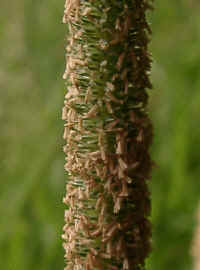Grasses are the largest and most important family of
the flowering plants. They provide man and his domestic animals with the main
necessities of life, they add diversity to the landscape and stability to
the ground surface; they have ornamental and amenity value. (More here)
There are 620 genera and 10,000 species in the world, of which there are only 54 genera
and 160 species indigenous to or naturalized in Britain.
Classification and Structure
Because Grasses, Sedges and Rushes are very similar to each other in some respects, it may
be useful to point out their similarities and differences.
 |
They are
all flowering plants. This means they all have their seeds
enclosed in ovaries, which are surrounded by bracts (modified leaves, associated with
flowers). In those flowering plants whose seeds are produced
as a result of pollination by insects, the bracts (also known in many cases as petals) are
often large, brightly coloured and sometimes perfumed. These petals are used to attract
insects (left). |
Grasses, Sedges and Rushes |
 |
Grasses, sedges and rushes
are wind pollinated. As wind is used to carry pollen from the male to the female part of
the flower, the flower has no need of showy petals and these are often reduced or absent. Other features then become important, such as having very light pollen which
can be easily blown by the wind, and very feathery, prominent stigmas which can catch the
pollen easily.
Left: Grass flower head with stamens hanging out to
release their pollen into the wind. |
Continue
|

